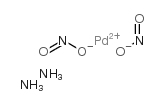14852-83-6
| Name | Diamminepalladium (II) nitrite |
|---|---|
| Synonyms |
PALLADIUM DIAMINE NITRITE
Diamminedinitropalladium |
| Density | 1.027 g/mL at 25ºC |
|---|---|
| Melting Point | 230ºC(lit.) |
| Molecular Formula | H6N4O4Pd |
| Molecular Weight | 232.49200 |
| Exact Mass | 231.94200 |
| PSA | 111.46000 |
| LogP | 1.14900 |
|
Section 1: Product Identification Chemical Name:Diamminepalladium (II) nitritesolution (5% Pd) CAS Registry Number:14852-83-6 Formula:Pd(NH3)2(NO2)2 EINECS Number:238-918-0 Chemical Family:metal-ammine complexes Synonym:DiammineBis(nitro)palladium, Diamminenitropalladium (II), Diamminenitro palladium
Section 2: Composition and Information on Ingredients IngredientCAS NumberPercentACGIH (TWA)OSHA (PEL) Title Compound14852-83-610%no datano data water7732-18-590%no datano data Section 3: Hazards Identification Emergency Overview:Irritating to skin, eyes and respiratory tract. Primary Routes of Exposure:Ingestion, inhalation Eye Contact:Causes mild to moderate irritation of the eyes. Skin Contact:Causes slight to mild irritation of the skin. Inhalation:Irritating to the nose, mucous membranes and respiratory tract. Ingestion:Nitrite poisoning results in the blood loosing its capacity to carry oxygen.. Irritating to skin, eyes, mucous membranes, and respiratory tract. Nitrite poisoning causes, dizziness, collapse, Acute Health Affects: rapid heart beat, irregular breathing, coma, convulsions, and death. The chronic toxicological properties of this compound have not been thoroughly investigated. Unrecognized Chronic Health Affects: hazards may be present. NTP:No IARC:No OSHA:No SECTION 4: First Aid Measures Immediately flush the eyes with copious amounts of water for at least 10-15 minutes. A victim may need Eye Exposure: assistance in keeping their eye lids open. Get immediate medical attention. Wash the affected area with water. Remove contaminated clothes if necessary. Seek medical assistance if Skin Exposure: irritation persists. Remove the victim to fresh air. Closely monitor the victim for signs of respiratory problems, such as difficulty Inhalation: in breathing, coughing, wheezing, or pain. In such cases seek immediate medical assistance. Seek medical attention immediately. Keep the victim calm. Give the victim water (only if conscious). Induce Ingestion: vomiting only if directed by medical personnel. SECTION 5: Fire Fighting Measures Flash Point:not applicable Autoignition Temperature:none Explosion Limits:none Extinguishing Medium:water, carbon dioxide, foam or dry powder If this product is involved in a fire, fire fighters should be equipped with a NIOSH approved positive pressure Special Fire Fighting Procedures: self- contained breathing apparatus and full protective clothing. Hazardous Combustion andIf involved in a fire this material may emit toxic fumes. Decomposion Products: Oxidizer when dry. A combustible material upon which the liquid has dried will burn in the absence of oxygen. Unusual Fire or Explosion Hazards: SECTION 6: Accidental Release Measures Small spills can be mixed with vermiculite, sodium carbonate or other suitable non combustible adsorbent and Spill and Leak Procedures: swept up. SECTION 7: Handling and Storage Handling and Storage:Store in a tightly sealed container. SECTION 8: Exposure Controls and Personal Protection Eye Protection:Always wear approved safety glasses when handling a chemical substance in the laboratory. Skin Protection:Wear protective clothing and gloves. Ventilation:To minimize exposure, handle the material in an efficient fume hood. If ventilation is not available a respirator should be worn. The use of respirators requires a Respirator Respirator: Protection Program to be in compliance with 29 CFR 1910.134. Ventilation:To minimize exposure, handle the material in an efficient fume hood. Additional Protection:No additional protection required. SECTION 9: Physical and Chemical Properties Color and Form:colorless to light yellow liq. Molecular Weight:232.47 Melting Point:no data Boiling Point:no data Vapor Pressure:not applicable Specific Gravity:no data Odor:none Solubility in Water:material is a water solution SECTION 10: Stability and Reactivity Stability:air and moisture stable Hazardous Polymerization:no hazardous polymerization Conditions to Avoid:none Incompatibility:active metals Decomposition Products:nitrogen oxides and palladium salts (when water is removed and residue is heated to decomposition) SECTION 11: Toxicological Information RTECS Data:No information available in the RTECS files. Carcinogenic Effects:No data Mutagenic Effects:No data Tetratogenic Effects:No data SECTION 12: Ecological Information Ecological Information:No information available SECTION 13: Disposal Considerations Disposal:Dispose of according to local, state and federal regulations. SECTION 14: Transportation Shipping Name (CFR):Non-hazardous Hazard Class (CFR):NA Additional Hazard Class (CFR):NA Packaging Group (CFR):NA UN ID Number (CFR):NA Shipping Name (IATA):Non-hazardous Hazard Class (IATA):NA Additional Hazard Class (IATA):NA Packaging Group (IATA):NA UN ID Number (IATA):NA SECTION 15: Regulatory Information TSCA:Listed in the TSCA inventory. SARA (Title 313):Not regulated by Title 313. Second Ingredient:Listed in the TSCA inventory. Not regulated. SECTION 16 - ADDITIONAL INFORMATION N/A |
| Hazard Codes | Xi: Irritant; |
|---|---|
| Risk Phrases | R36/37/38 |
| Safety Phrases | S26-S36 |
